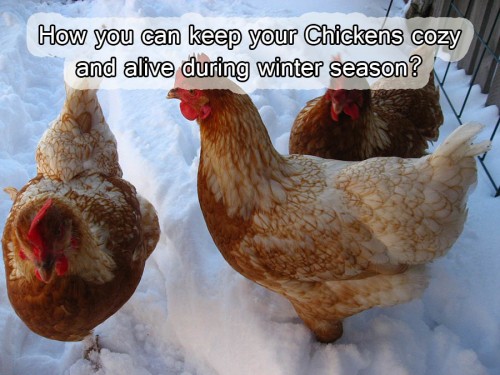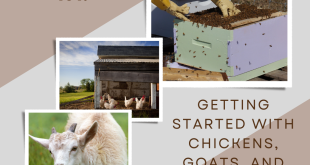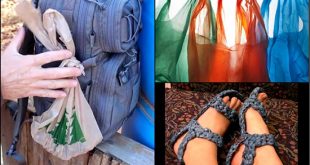How you can keep your Chickens cozy and alive during winter season?

Like me, if you also have seen your chicken getting cold during the middle of the night, here are some useful tips for keeping them warm and cozy during the winter season.
Cold weather and Chicks:
Cold can be a problem for your chicks, therefore they need a constant follow up when it arrives. If you see them clustered together and peeping loudly, then it means that the cold weather is giving them a tough time. You immediately need to increase the temperature by lowering your red light. Place a thermometer which is not a digital one at their level, a cheap thermometer can do the job. This is substantial so that the chicks are not overheated. 95 degrees or a little higher is the ideal temperature for the young chicks in the first week, afterwards the temperature can drop to a few degrees each following week.
It is imperative that the brooder is kept in a location which is free of draft and it should not touch the cement floor. Ample cushion is obligatory between the floor and the chicks, a furry linen can serve this purpose well if it’s a few inches thick. It is a must to bring the chicks inside, if in case the power is interrupted due to some reason. The chicks will have to be comforted with an alternate heating source to keep them alive, this source can be a wood stove. The thermometer will help you find the right place for the chicks near the stove.
Breeds for cold weather:
The cold weather is not much of a problem for most of the adult chickens. Although it is not a very enjoyable weather for them, but they manage to handle it well. Cold hardy breeds should be given preference in areas where it is common to observe the temperature going below zero. These double purpose breeds consist of Sussex, Buckeyes, Barred Rocks (Plymouth Rocks), Orpingtons, Australorps, Jersey Giants, Brahmas, Rhode Island Reds and Delawares.
Increasing the daylight hours:
The hardy breeds can manage to produce more than a few eggs. You may require to set a heavy duty light which is used for outdoor purpose, it is essential to do this when the daylight has not started dropping. Producing the eggs is the target to be achieved in the winters. The egg production may slow down or can be closed if the hens do not get a minimum of 14 hours of daylight. It has also been observed that there is just a minor drop in the production of eggs, if the lights are not used.
Managing cold:
Mostly people are interested in leaving a light or heater on all day evaluating most of the castings the cold winter season and in order to comfort their chickens. In most of the cases, the experts do not recommend this. Chickens are quite sturdy, but many people are unaware of it. This also increases the chance for the fire to get on.
The 100-watt light bulb burns at 200º F; a lamp used for heating at 500 º F, wood burns at 575º – 600º F. Their fluffy feathers will burst into flames at a far higher temperature.
$24+ per month will be the electric bill if a heat lamp (250w) runs all the time, furthermore making the chicken used to the very warm coop will make the chicken suffer from a great deal of hard times if the service gets disconnected when a snow storm comes. This fact should be kept in mind that even in the normal weather it is difficult for the chicken to go out of a warm coop.
Keeping the breed out of the wind and humidity is the finest protection from the winter season. The coop should be enclosed at night so that the wind is hindered from entering in.
Many of the cold hardy chickens did fine, even at the time when the temperature is floating nearby zero and have been observed managing quite well even at below freezing temperature. They make use of their 8,300 feathers quite effectively in winters to protect themselves from the heat. Still, they can be caught by frostbite on their combs and feet, in such a case they can be comforted by applying a little Vaseline to the affected area before dark if you observe that the chicken is backbiting.
Vaseline is not used to keep the affected area warmer in fact, if helps prevent the moisture from freezing on the frostbite. Chicks are not mammals and their reaction to cold weather is different to mammals, they are much more adaptable to cold than mammals. Nevertheless, if it so cold that the parts of chicken start freezing, Vaseline is not effective. Placing wide poles or branches will make the birds sit on them and this will eventually keep their feet warm, 2x2s can be used in a normal size coop.
Managing extra heat if required:
Rarely, it might happen, but in case the cold becomes unbearable you might need an additional heater. A 60-100 watt light bulb will do good in this condition, but not a heat lamp bulb. This will be sufficient to protect the chickens from the cold and is less of a fire risk than a 250 watt heat bulb.
The lights should be kept in 2 places in case one connection fails other can operate furthermore, it should be out of the reach of the chicken. There have been cases where the chicken coops catch fire and the chance of survival of the chicken is less.
The light has to be removed when the cold snap is over. If the cold snap persists accompanying with the power outage the chicks have to be moved to a warmer location. They can be kept in the basement or garage and if needed in the house too. You can do this with the help of dog crates.
Managing Essential Ventilation:
While securing your coop from the cold in the evening, ventilation should be taken care of, otherwise moisture will be collected inside the coop resulting in frostbites. Vents can help you in this regard, they are placed high on the coop walls. The litter of the chickens should be clean and dry for this purpose. Keeping the litter system a little deeper will also protect the coop from the moist to increase in the coop.
Chickens cluster together and stay warm. It is said that one chicken can produce about 10 watts of heat as per this calculation heat up to 100 watts can be produced if you have 10 chickens huddled together in
Your coop. Frostbite will not be witnesses until there is damp and humidity inside the coop. Wood pellets can also be used to absorb extra moist efficiently.
H2O
Fresh supply of water is a major concern in the poultry during the winter season. If transporting water to your chickens twice a day is an issue for you can build your own chicken waterer which brings into use submersible aquarium heater or you can go for a store-bought waterer with a built-in heater. Otherwise, the old base heaters are still an option, the metal poultry waterer is placed on these and it heats the water from below by an internal thermostat. The chicken must not be left without fresh water for more than a few hours when the cold is at its peak.
Chicks and Snow:
Snow is not liked by most of the chickens, therefore when the coop is open in the morning in order to give your chicken an option to go out and roam around most of them will not like to march outside the coop, especially when the snow is deep and the temperature outside is below 20 degrees. Therefore, the snow should be moved away so that they come out and enjoy the fresh air. It might happen that the chicks get restless in the coop and still don’t come outside, in such a situation you can keep the busy by hanging from the top of the coop half a head of cabbage and let them enjoy all day by chopping it.
Warm Nutrition
The extremities of winter can abstain you from going out in the market to get feed for my chickens, therefore, a stock of their feed is a must to keep. The source of their feed should be maintained at all times so that they don’t go hungry. The oldest food should be given first, it will bring no harm and will not take much space.
At times, some warm food can be given to them such as oatmeal in a cold morning. Oatmeal of any kind will do well and they will like the meal. Corn scratch can be given in the evening and it will keep them keep warm all the night. A high protein diet will also help them keep warm.
Keeping the chicks safe from the winter is not tough if the right precautions are taken. Hope this article will help you in this regard.
 Home and Gardening Ideas At home and Gardening ideas we believe inspiring readers about homesteading, self sufficiency
Home and Gardening Ideas At home and Gardening ideas we believe inspiring readers about homesteading, self sufficiency





